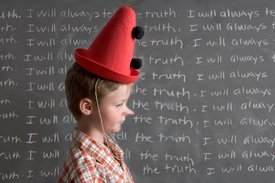 The camera lies to you.Á‚ Sure, that idea goes against everything you were raised to believe.Á‚ Court cases often rely on photographic or videotaped evidence to prove guilt or innocence.Á‚ Newspapers employ teams of photographers to provide a visual representation of the news.
The camera lies to you.Á‚ Sure, that idea goes against everything you were raised to believe.Á‚ Court cases often rely on photographic or videotaped evidence to prove guilt or innocence.Á‚ Newspapers employ teams of photographers to provide a visual representation of the news.
Still, it’s all lies.Á‚ Why?Á‚ The simple fact of the matter is that a camera has boundaries.Á‚ The viewer can never know what it is that lies beyond the edges of the frame.Á‚ Taking a picture isn’t about what is shown so much as it is about what isn’t.Á‚ One of the greatest photojournalists, W. Eugene Smith, was often known to insert an agenda into his images.Á‚ Joe Rosenthal’s famous photograph of the flag being raised at Iwo Jima has sparked controversy regarding its truthfulness.
What does this have to do with filmmaking?Á‚ The entire process of making a movie is about hiding things from the viewer and manipulating their emotions.Á‚ One of the most important lessons that a screenwriter can learn is the old axiom, “show it, don’t say it.”Á‚ This often goes against the instincts of the writer, and perhaps the rejection of this has resulted in the flood of Tarantino-esque dialogue that has saturated the industry.
Next in the line of deceit is the actual shooting of the film.Á‚ The great Sergio Leone effectively employed the edges of the frame to his advantage.Á‚ In The Good, The Bad, and The Ugly, Tuco and Blondie are well on their way to the cemetery and the gold.Á‚ Suddenly the camera changes position, revealing a gigantic Union Army camp.Á‚ If one were to think about this scene logically, it would be impossible to believe that Tuco and Blondie couldn’t see the camp.Á‚ However, in Leone’s vision, the camera dictates the experience.
Conversely, there are some glaring examples of filmmakers who have rejected this method and failed.Á‚ George Lucas is a filmmaker who was once limited by the technology he had to work with.Á‚ He was famously displeased with what he was able to accomplish on the original Star Wars film, decrying the limitations of 1970s technology.Á‚ However, one only needs to look at the modern Star Wars trilogy to see the error of his faith in technology.
Lucas is a filmmaker who needs to be confined within his artistic sandbox.Á‚ When he had borders, he pushed against them and released his creativity.Á‚ Within the last decade or so, he has been working with a sandbox the size of the Gobi desert.Á‚ So what happened when technology stopped dictating how he displayed his vision?Á‚ He tried to show too much.Á‚ The result was a muddled, chaotic mess.Á‚ Not to mention that his scripts attempted to explain away the mysteries and subtext of his once great, fantastical world.
The third stage of deception occurs in the editing of the film.Á‚ It would be interesting to see an audience reaction to raw footage.Á‚ Smart filmmakers know that the greatness of their art is dictated by how much they limit what the audience sees.Á‚ One may do 30 takes of a particular scene and only have 1 that is good.Á‚ Oftentimes, the best take is accidental and resulting in an actor’s true instincts shining through his or her performance.
The greatest artists probably understand this sentiment.Á‚ Terrence Malick is a filmmaker who has made only five films since 1973.Á‚ Is the secret of his greatness found within the limitations of what he shows us?Á‚ Perhaps, if Malick made as many films as his contemporaries he wouldn’t be so highly thought of by cinephiles.
It is the mechanization of art that results in the creation of the derivative.Á‚ This is the very problem that studios face today.Á‚ The overuse of CG to show rather than to hide has become an obstacle in the way of creating fine films.Á‚ Watch what happens to movies once the summer months begin to approach.Á‚ There is a feeling of emptiness that saturates those films as studios churn them out without any thought.Á‚ The tendency is to shoot for the CGI rather than around it.
Perhaps you will accept a challenge.Á‚ The next time you watch a film, attempt to watch it with all of this in mind.Á‚ Try to imagine what that the scenes are all extended on either end.Á‚ Imagine the director’s voice shouting “action!” and “cut!” Think about what dialogue could be trimmed.Á‚ The elimination of unnecessary dialogue does a lot to make a writer look good.
You can thank me later for ruining your DVD experience of Hancock.Á‚ But just imagine how much better your home movies will be once you employ this method.


Comments